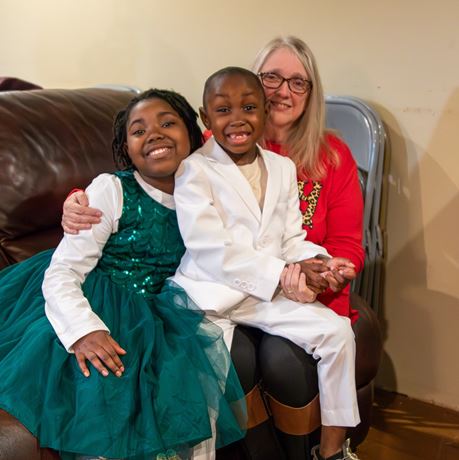%20w%20Captions%20(8).png?mw=800&sh=6117d)
When Cedric and Bonnie Saunders adopted four children from Texas in May, they knew that there would be challenges at home, but they weren’t prepared for just how difficult it would be.
The couple, now in their 60s, had already raised six now-adult children, two of whom were also adopted. Now, as parents to four kiddos, ages 10, 8, 6, and 4, Cedric and Bonnie had to navigate parenthood all over again, but this time with children who had experienced trauma and personal harm.
“The four of them are siblings and distant cousins of Cedric,” said Bonnie. “We just needed the help because they all have special needs and have been through some type of trauma.”
Cornerstones of Care recommended that Cedric and Bonnie get involved with the Behavior Intervention Support Team (BIST) In-Home services to receive weekly assistance from an in-home consultant. BIST is a trauma-informed, psycho-educational model based on the concepts of grace and accountability.
For one year, Linda Hosman, Lead BIST Consultant, visited the Saunders family weekly to support them with emotion regulation, discipline and parent leadership, procedures and routines, and more. The one-to-two-hour visits included various combinations of family members and full-group sessions.
 “As BIST Consultants, we are basically family coaches and educators,” said Linda. “We work with the parents to better work with kids who have experienced trauma.”
“As BIST Consultants, we are basically family coaches and educators,” said Linda. “We work with the parents to better work with kids who have experienced trauma.”
One particularly challenging area for the Saunders family was bedtime. The older two kids struggled with sleep more than the others, and sometimes their tantrums would become violent. Linda helped the parents recognize that tantrums and other problematic behaviors are symptoms of an unmet need or a skill deficit, not something inherently wrong with the child.
“The first skill we want to teach parents is to intervene early,” said Linda. “That means anytime a kiddo is not doing what we often call the ‘expected behavior,’ we stop them. Early intervention allows parents to intervene without emotion, and I think that is a huge success.”
From there, Linda guided the parents on how to respond to “out-of-bounds behavior” in a caring and effective way.
“She taught us not to blame,” said Cedric. “If a child is irrational, they’re not thinking with the correct part of their brain; you have to help them until they get regulated.”
Linda also taught them the importance of talking quietly to the kids and staying relaxed even during tense interactions.
Over time, the tantrums have become much less prominent, and Cedric and Bonnie feel more confident that they have the tools they need to handle behaviors when they come up.
When collaborating with families to address difficult behaviors, Linda and the other BIST In-Home Consultants use activities and games to teach important concepts and skills. One of the games Linda played with the Saunders family was “Mother, May I?” which focused on establishing parental authority and trust with the children.
“Trust is a big factor,” said Cedric. “What she conveyed to us is that they need to trust us because their life was so unpredictable that they learned they couldn’t trust adults. They were in survival mode. They’re still learning to trust that we’re doing the best for them.”
 All the tools, skills, and principles that BIST In-Home Consultants teach families – like early intervention – are nearly identical to those taught in schools through the BIST program. Most people will recognize BIST as a school-based program that supports teachers, administrators, and other school staff as they partner with students to address behavioral issues. First introduced to schools in 1989, the BIST program has grown to include more than 330 schools in nine states.
All the tools, skills, and principles that BIST In-Home Consultants teach families – like early intervention – are nearly identical to those taught in schools through the BIST program. Most people will recognize BIST as a school-based program that supports teachers, administrators, and other school staff as they partner with students to address behavioral issues. First introduced to schools in 1989, the BIST program has grown to include more than 330 schools in nine states.
While BIST has always recognized the need to incorporate parents and families into the process, in-home services have only been formally offered to families since 2021, when the program received a three-year Placement Stability Grant through the Department for Children and Families (DCF) in Kansas.
Linda joined the BIST team as a consultant in 2005 and has been a champion for in-home services since she started. Like many BIST consultants, Linda’s background in education drew her to the program, but it’s her lived experience as a foster and adoptive parent that perhaps makes the biggest difference in her job.
“My husband and I became licensed as foster parents in 1992,” said Linda. “We did a private adoption and thought we’d only adopt one more.”
That was before they discovered just how many kids were available for adoption in the state of Missouri. Since then, they’ve raised 15 children, four of whom refer to themselves as “the originals.” The others have joined the family through adoption or guardianship.
“I can honestly say I live it,” said Linda. “I really, truly am passionate about what I get to do. It’s wonderful to have a job where I get up and say, ‘Who do I get to see today?’”
According to Linda, the BIST In-Home program is successful for families because it gives them strategies that empower rather than rescue them from their situation, which provides a sense of hope to everybody.
“Learning strategies to put that philosophy into practice equips kids to recognize that they can change and that their life does not have to stay like this,” said Linda. “They are not a product of what has happened to them.”
In short, foster and adoptive families face many challenges, especially when there has been a history of trauma and neglect. But when families are given the gift of hope, accompanied by tangible tools and skills that can be used from day one, they start believing in themselves and seeing a path forward. And when someone with real-life experience like Linda can be by their side the whole way, then anything is possible.
“Praise the Lord for Linda,” said Bonnie. “She has been a big help.”


